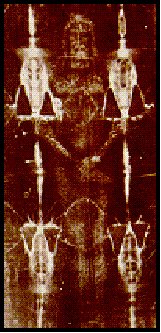 Therefore, the water probably represented serous pleural and pericardial fluid, (5-7,11) and would have preceded the flow of blood and been smaller in volume than the blood. Perhaps in the setting of hypovolemia and impending acute heart failure, pleural and pericardial effusions may have developed and would have added to the volume of apparent water. (5,11) The blood, in contrast, may have originated from the right atrium or the right ventricle or perhaps from a hemopericardium. (5,7,11) Jesus' death after only three to six hours on the cross surprised even Pontius Pilate. (1) The fact that Jesus cried out in a loud voice and then bowed his head and died suggests the possibility of a catastrophic terminal event. One popular explanation has been that Jesus died of cardiac rupture. In the setting of the scourging and crucifixion, with associated hypovolemia, hypoxemia, and perhaps and altered coagulable state, friable non-infective thrombotic vegetations could have formed on the aortic or mitral valve. These then could have dislodged and embolized into the coronary circulation and thereby produced an acute transmural myocardial infarction. Thrombotic valvular vegetations have been reported to develop under analogous acute traumatic conditions. (39) Rupture of the left ventricular free wall may occur, though uncommonly, in the first few hours following infarction. (40) However, another explanation may be more likely. Jesus' death may have been hastened simply by his state of exhaustion and by the severity of the scourging, with its resultant blood loss and preshock state. (7) The fact that he could not carry his patibulum supports this interpretation. The actual cause of Jesus' death, like that of other crucified victims, may have been multifactorial and related primarily to hypovolemic shock, exhaustion asphyxia, and perhaps acute heart failure. (2,3,5-7,10,11) A fatal cardiac arrhythmia may have accounted for the apparent catastrophic terminal event. Thus, it remains unsettled whether Jesus died of cardiac rupture or of cardiorespiratory failure. However, the important feature may be not how he died but rather whether he died. Clearly, the weight of historical and medical evidence indicates that Jesus was dead before the wound to his side was inflicted and supports the traditional view that the spear, thrust between his right ribs, probably perforated not only the right lung but also the pericardium and heart and thereby ensured his death. Accordingly, interpretations based on the assumption that Jesus did not die on the cross appear to be at odds with modern medical knowledge.
|
|
| Back | Next |